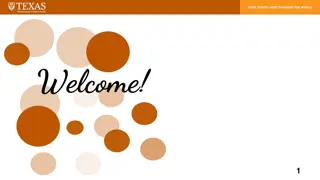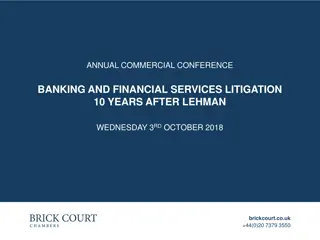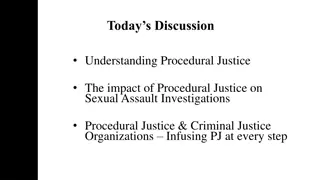Guide to Collecting Judgments: Procedural Insights and Strategies
This comprehensive guide covers the post-judgment process, including discovery, liens, garnishments, and more. Learn about debtor examinations, filing procedures, and dealing with uncooperative debtors in the context of judgment collection. Gain valuable insights from legal experts and a nationally-recognized collections firm.
Download Presentation

Please find below an Image/Link to download the presentation.
The content on the website is provided AS IS for your information and personal use only. It may not be sold, licensed, or shared on other websites without obtaining consent from the author. Download presentation by click this link. If you encounter any issues during the download, it is possible that the publisher has removed the file from their server.
E N D
Presentation Transcript
Collecting a Judgment: A Procedural Guide W E L T M A N, W E I N B E R G & R E I S C O., L. P. A Presented by: Stefanie Kempfer Collier, Esq. Jack W. Hinneberg, Esq. Weltman, Weinberg & Reis Co., LPA September 27, 2017
Weltman, Weinberg & Reis, Co., LPA (WWR) Nationally-recognized full service collections firm We represent nearly every type of creditor, including some of the largest financial institutions in the U.S., in: Bankruptcy Consumer and commercial collections Litigation Real Estate Default matters We operate with the strictest adherence to compliance and security standards, with a premium on reputation management To learn more about our leaderships in accounts receivables management, visit weltman.com
Introduction Post-Judgment Discovery Judgment Liens Wage Garnishments Bank Attachments Levies Charging Orders Receiverships Exemptions Fraudulent Transfers
Post Judgment Discovery: Debtors Examination Creditor s examination: What is a debtor s examination? ORC 2333.09 Examination must concern: Property Income Other means of satisfying judgment
Debtors Examination Where to file a debtor s examination Court in which judgment was rendered Jurisdiction in which debtor resides FDCPA considerations Service issues Bailiff, sheriff, or special process server Personal service Residential service
Debtors Examination What if the debtor, although properly served, fails to appear? ORC 2333.11 Order of Arrest May Issue In reality, court may require a motion to show cause, which will require service a second time
Debtors Examination Other Considerations Necessity of a court reporter Bond issues Chance for resolution or payment plan Fraud (ORC 2333.15) The difficult debtor what to do with debtors who will not answer the questions
Ohio Civil Rule 69 In aid of the judgment or execution, the judgment creditor or his successor in interest when that interest appears of record, may also obtain discovery from any person, including the judgment debtor in the matter provided by these rules . Third parties Individuals with knowledge about the judgment debtor s assets Spouses, boyfriend/girlfriend, business partners, tenants Ohio Civil Rule 45 subpoenas for non-parties Other considerations: Requesting the documents Enforcement against third-parties who fail to appear FDCPA considerations
What is a Judgment Lien? A lien arising from a monetary judgment ORC 2329.07 Civil judgment is valid within five years from the date of judgment or within five years from the date of issuance of the last execution thereon or issuance an filing of last such certificate, whichever is later Under R.C. 2329.02, a creditor may place a judgment lien upon real property owned by the debtor
Judgment Liens Once a money judgment is obtained, a lien can be placed on debtor s real property by obtaining Certificate of Judgment from court in which judgment was originally issued and by filing a copy with the Clerk of Court s office where the subject land that the attorney is attempting to attach is located. A Certificate of Judgment that is obtained in one county can be certified in another.
Judgment Liens Once the Certificate of Judgment is filed with the court, it becomes a lien on all real property owned by the judgment debtor in that specific county It remains a lien for five years after the filing It attaches to the judgment debtor s property in prior order (first filed = first in priority)
Judgment Liens A certificate of judgment will contain: The name of the court in which the certificate was rendered Title and number of the action Names of creditors and debtors Amount of the judgment and costs Rate of interest If the judgment provides for interest Date of rendition of judgment Volume and page or journal entry number
Judgment Liens A lien can be renewed by filing a renewal certificate of judgment in the same court If done prior to the expiration date of the five-year period, the creditor will not lose its place in the order of priority Placing a judgment lien against a debtor s property is a pre-requisite before a foreclosure action can be filed Judgment creditors often place a lien against a debtor s property, then wait until they sell or refinance The lien will have to be paid from the proceeds before a good and marketable title to the property can be transferred
Judgment Liens In Ohio, there is no requirement that a creditor obtain a certificate of judgment and place a lien against real property before executing against a judgment debtor s personal property When a credit chooses to execute against a debtor s personal property, it is commonly accomplished through execution, seizure, and sale by a county sheriff or municipal court bailiff
What is a Wage Garnishment? Order of garnishment requires an employer to hold wages on a continuous basis If an employer receives subsequent garnishments against the same employee, garnishments are processed in the order they were received Each garnishment will be processed for a minimum of 182 days Only entitled to 25% of a judgment-debtor s net income pursuant to a wage garnishment.
Wage Garnishments Procedure A statutory demand is served on the judgment debtor By certified mail, regular mail with proof of mailing, or bailiff service Judgment debtor has 15 days to do one one of the following: Pay the judgment in full Pay an amount that would be obtained on a single garnishment File bankruptcy File a municipal court trusteeship Enter a debt scheduling program
Wage Garnishments Procedure If the judgment debtor elects to send in the amount of money that would have been obtained for a single garnishment cycles, a judgment creditor cannot mail another statutory demand until the end of the pay period In order to comply the statutory demand for payments the debtor must: Have his employer sign the statutory demand, or Send in two pay stubs to verify the amount paid was correct
Wage Garnishments Procedure If the judgment debtor elects to send in the amount of money that would have been obtained for a single garnishment cycles, a judgment creditor cannot mail another statutory demand until the end of the pay period In order to comply the statutory demand for payments the debtor must: Have his employer sign the statutory demand, or Send in two pay stubs to verify the amount paid was correct
Wage Garnishments Procedure If the judgment debtor fails to respond to the statutory demand, the judgment creditor must file: An affidavit of garnishment with the statutory demand and proof of mailing attached Order of Garnishment and Answer of Garnishee Hearing Notice for Debtor Request for Hearing Form Interim Report and Answer Final Report and Answer
Wage Garnishments Copies Order of Garnishment & Answer: At least 4 Hearing Notice: At least 3 Requesting for Hearing: At least 3 Interim Report: At least 2 Final Report: At least 2
Wage Garnishment Fees Filing fees run from $20 to $150 Employer can deduct $3 from the funds withheld from each pay as its fee No fee can be charged if no funds are withheld $3 fee may be added as a court cost Interim report provides instructions to the employer regarding the fee
Wage Garnishments Procedure Questions to ask when getting ready to file a garnishment: Does the court has it own forms? Does your office have its own forms? Do you have the right number of copies? Is your court cost check correct? Has the statutory demand time run?
Wage Garnishments Procedure Service Statewide jurisdiction If garnishee (employer) is within the court s territorial jurisdiction, service is by same manner as summons If garnishee is outside the territorial jurisdiction service is completed by: Personal service by proper office of the county in which the garnishee operates Certified mail Regular mail with proof of mailing
Wage Garnishments Procedure How do you know where to serve a wage garnishment? Ohio Secretary of State Research Information from Debtor Review of file Internet research
Wage Garnishments: Employer Obligations Within five days, complete answer of garnishee and return it to the court Withhold money from first full pay period following the pay period that garnishment is received Complete interim report within 30 days of withholding the funds; send report and funds to the court If employer fails to respond, creditor may file a Motion to Show Cause against the employer for its failure to comply
Wage Garnishments Request for Hearing The judgment debtor has a short window to request a hearing and argue that the garnishment funds are exempt from execution Must be set within 12 days of filing the garnishment Court must issue to garnishee not more than 7 days prior to date of hearing: 3 copies of Order of Garnishment Written notice of garnishee s obligation to respond to garnishment
Wage Garnishments Debtor does not have to state basis of hearing request on this form At hearing, debtor must state reason for hearing and why objecting to attachment Garnishment modification
Stacking of Wage Garnishments There may be occasions when an employer gets more than one garnishment for one of its employees Garnishments of same priority 182 day rule Garnishments of higher priority Child support, tax, etc. Priority garnishments are paid first
Wage Garnishments: Final Report To be filed with the court when employer ceases sending funds Should indicate reason why garnishment is terminated Should provide total amount of money paid on the garnishment
Why Would a Garnishment Terminate? Probable amount of judgment has been paid Creditor indicates the judgment is otherwise paid Debtor enters a municipal court trusteeship program Debtor files bankruptcy Receipt of a garnishment of higher priority Exhaustion of 182 day period and another garnishment has been filed Debtor is no longer employed
Release of a Garnishment Creditor s attorney may send notice to the employer Should be served on both the employer and debtor by personal or certified mail service If the debtor files bankruptcy, the filing of the release is the most effective method to ensure a timely release of the garnishment
Bank Attachments Garnishing property other than personal property, through a bank attachment, occurs periodically Creditor seeks to attach funds of the debtor on deposit with a financial institution No notice is required Bank attachments are a one-time event
Bank Attachments Procedure initiated by filing an affidavit of the creditor Name of debtor Statement that affiant has good reason to believe that a third party (garnishee) has property other than personal earnings of the debtor that is not exempt Description of property to be attached (money, property, credits) Praecipe instructing clerk to issue to debtor a notice and hearing request form Check for cost of garnishee completing paperwork (fee is not to be charged to debtor as a court cost)
Bank Attachments Creditor will then obtain Garnishment Order that contains a notice to the garnishee as well as an answer for the garnishee to complete Notice must also be served on debtor with a Request for Hearing Form All courts can serve bank attachments throughout the state Must be set within 12 days of filing
Bank Attachments Court must issue to garnishee not more than 7 days prior to date of hearing: 3 copies of Order of Garnishment $1 fee Written notice of garnishee s obligation to respond to garnishment Debtor has five business days after receipt of notice to request a hearing
Attachments & Levies See Attachment 6 Court officer is permitted to go onto debtor s property to collect and sell available tangible personal property Court officer has no right to enter residence to collect property Must determine if personal property has liens that may affect equity amount
Attachments & Levies Keep in mind the value of the property, the cost to sell the property, and the deficiency amount Once judgment is granted, file a judgment lien Lien is effective against any real property owned by the debtor in any county, at the time of filing
Executions May be issued any time after judgment is obtained A process of a court, issued by its clerk, and directed to Sheriff of the county May be issued to Sheriffs of different counties at the same time Procedure for execution (governed by O.R.C. 2329) First step: file praecipe with Clerk of Courts where subject property is located requesting that Writ of Execution be issued If original judgment was obtained in different county or state, judgment must be filed as foreign judgment with Clerk of Courts in county and state that debtor wishes to proceed
Praecipe for Writ of Execution Must contain: Request that Writ of Execution be issued directing levying officer to levy on goods and chattels of debtor Specific description of property Where property is located Calculation of current amount due on judgment Statement for levying officer to contact attorney if there are any questions
Writ of Execution Issued by Clerk of Court to Bailiff or Sheriff s office Contains: Caption of the action Current amount due on judgment Specific description of property Levying officer has 60 days to return Writ and report to court This period cannot be extended Method of execution varies from court to court Creditor s lien on personal property does not arise until property is tagged/confiscated
After Property Has Been Seized Levying officer must appraise and advertise seized property Property must be appraised by 3 disinterested people Property shall not be sold for less than 2/3 of its appraised value
Sales Published notice of time and place of sale must be displayed for at least 10 days prior to sale in a newspaper published in and of general circulation in the county Sales are to be held at a public auction unless court orders otherwise Money realized from sale is applied against any excess costs for sale before being paid to creditors
Executions: A Warning Executing against personal property is not like executing against real property, where there is a foreclosure and all liens are marshaled and extinguished through the process Buyers have very little protection when purchasing real property at any such sale Any liens upon debtor s property will most likely remain and buyer will take property subject to pre-existing liens
Charging Orders ORC 1705.19 Rights of Judgment Creditor of Member If any judgment creditor of a member of a limited liability company applies to a court of common pleas to charge the membership interest of the member with payments of the unsatisfied amount of the judgment with interest, the court may so charge the membership interest. extent the membership interest is so charged, the judgment creditor has only the rights of an assignee of the membership interest. Nothing in this chapter deprives a member of the member s statutory exemption. To the
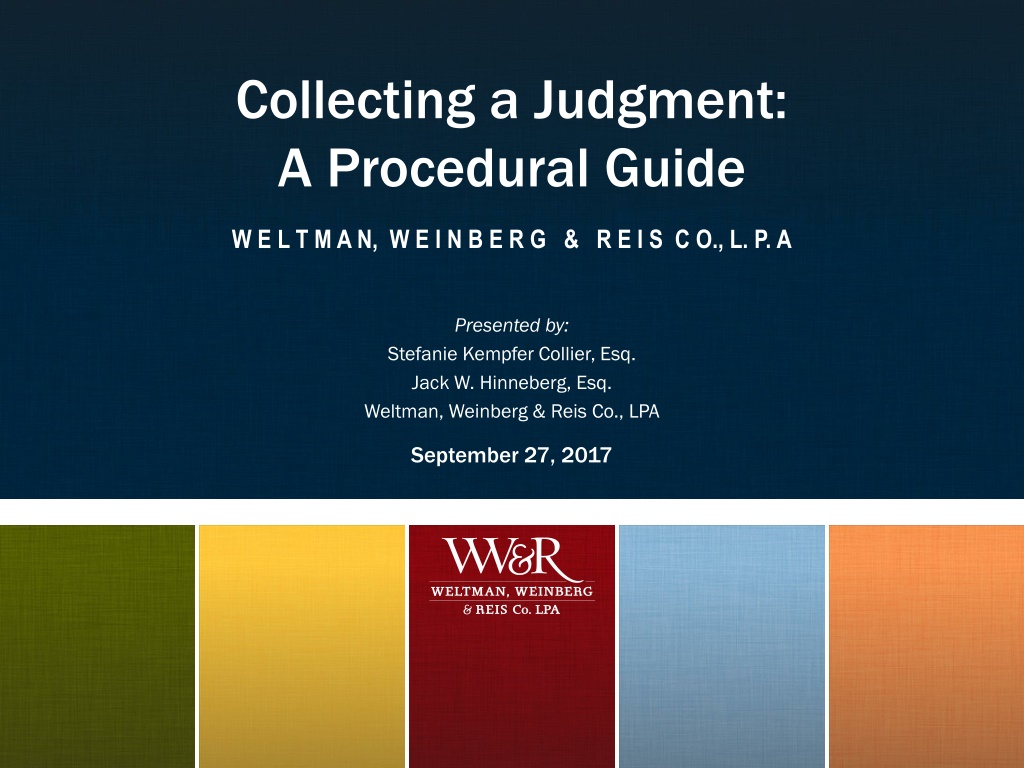






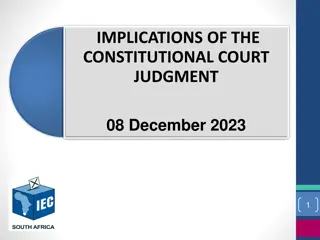




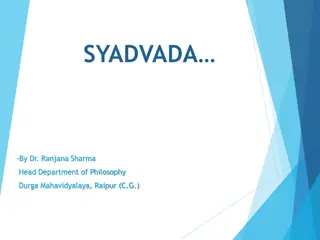
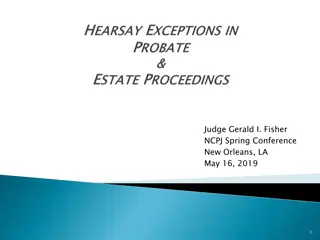



![Legal Dispute Analysis: FCA v ARCH and Others [2021] UKSC 1](/thumb/189783/legal-dispute-analysis-fca-v-arch-and-others-2021-uksc-1.jpg)
